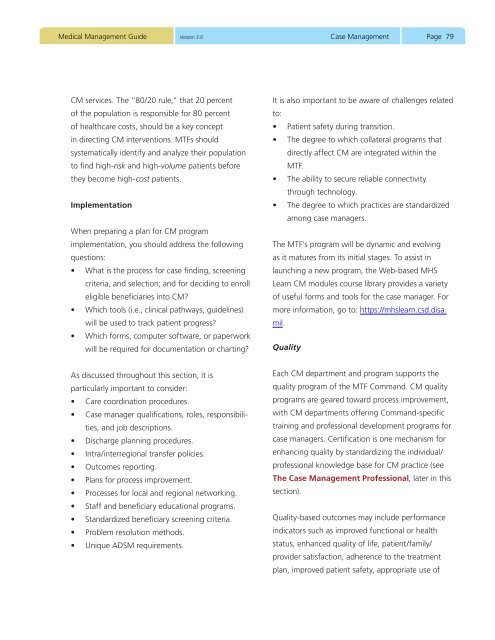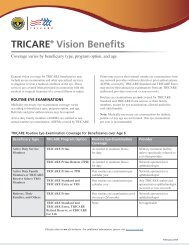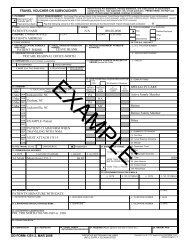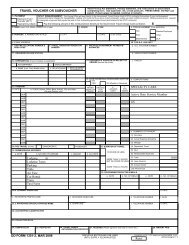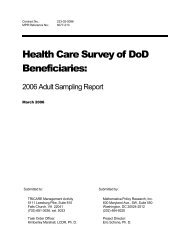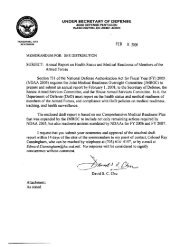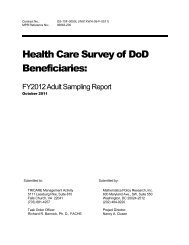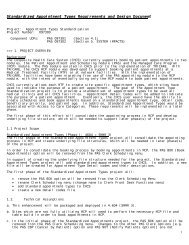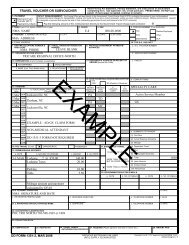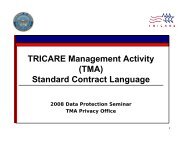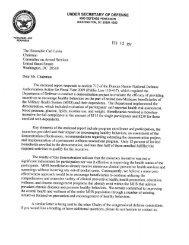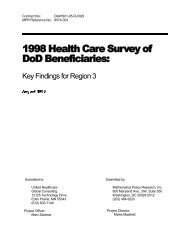Medical Management Guide, 2009, Version 3.0 - Tricare
Medical Management Guide, 2009, Version 3.0 - Tricare
Medical Management Guide, 2009, Version 3.0 - Tricare
- No tags were found...
You also want an ePaper? Increase the reach of your titles
YUMPU automatically turns print PDFs into web optimized ePapers that Google loves.
<strong>Medical</strong> <strong>Management</strong> <strong>Guide</strong><strong>Version</strong> <strong>3.0</strong>Case <strong>Management</strong>Page 79CM services. The “80/20 rule,” that 20 percentof the population is responsible for 80 percentof healthcare costs, should be a key conceptin directing CM interventions. MTFs shouldsystematically identify and analyze their populationto find high-risk and high-volume patients beforethey become high-cost patients.ImplementationWhen preparing a plan for CM programimplementation, you should address the followingquestions:• What is the process for case finding, screeningcriteria, and selection; and for deciding to enrolleligible beneficiaries into CM?• Which tools (i.e., clinical pathways, guidelines)will be used to track patient progress?• Which forms, computer software, or paperworkwill be required for documentation or charting?It is also important to be aware of challenges relatedto:• Patient safety during transition.• The degree to which collateral programs thatdirectly affect CM are integrated within theMTF.• The ability to secure reliable connectivitythrough technology.• The degree to which practices are standardizedamong case managers.The MTF’s program will be dynamic and evolvingas it matures from its initial stages. To assist inlaunching a new program, the Web-based MHSLearn CM modules course library provides a varietyof useful forms and tools for the case manager. Formore information, go to: https://mhslearn.csd.disa.mil.QualityAs discussed throughout this section, it isparticularly important to consider:• Care coordination procedures.• Case manager qualifications, roles, responsibilities,and job descriptions.• Discharge planning procedures.• Intra/interregional transfer policies.• Outcomes reporting.• Plans for process improvement.• Processes for local and regional networking.• Staff and beneficiary educational programs.• Standardized beneficiary screening criteria.• Problem resolution methods.• Unique ADSM requirements.Each CM department and program supports thequality program of the MTF Command. CM qualityprograms are geared toward process improvement,with CM departments offering Command-specifictraining and professional development programs forcase managers. Certification is one mechanism forenhancing quality by standardizing the individual/professional knowledge base for CM practice (seeThe Case <strong>Management</strong> Professional, later in thissection).Quality-based outcomes may include performanceindicators such as improved functional or healthstatus, enhanced quality of life, patient/family/provider satisfaction, adherence to the treatmentplan, improved patient safety, appropriate use of


